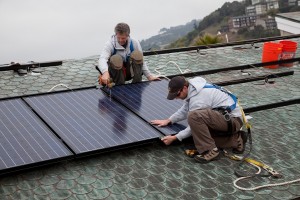Headache Remedy
Solar permitting can be a pain, but Clean Power Finance is working on a database to help.
By James Tong
Ask solar installers about their profession, and you’ll get a lot of passion and pride. Ask them about solar permitting, and you’ll get a lot of passion… and maybe some four-letter words. The permitting and interconnection process can be horribly complex — varying from one Authority Having Jurisdiction (AHJ) to the next and creating unnecessary and costly roadblocks for installers. Imagine playing for the NFL when each stadium had different rules regarding first downs, offsides, holding, etc., and then getting penalized each time you missed a rule variation, which (you learn after the game has started) can also vary depending on the referee. This is the playing field that solar PV installers face.
 A recent nationwide survey of 273 installers, conducted by Clean Power Finance, supports this. The survey, the largest of its kind, found that:
A recent nationwide survey of 273 installers, conducted by Clean Power Finance, supports this. The survey, the largest of its kind, found that:
- More than 1 in 3 installers avoid an average of 3.5 jurisdictions because of associated permitting difficulties.
- 23 percent of installations saw permitting costs exceed original expectations.
- 13 percent of installations had agency requirements change during the job.
- 1 in 9 installations encountered jurisdictions that had not even set requirements.
In other words, government bureaucracy is holding back solar. Installers frequently report having to educate AHJs on their own rules or discovering an obscure requirement (such as a need for a glare study) after driving miles to submit a permitting packet that took hours to complete. The confusion breeds frustration and adds costs, which are mostly absorbed by end consumers and installers. Independent studies have calculated that permitting adds $0.22 per watt to a system, or even $0.50 per watt if you factor in other associated cost like lost sales or referrals, wasted labor time and unnecessary rework.
The ideal solution would be to have all AHJs adopt the same standards, much like how in every city green, yellow and red traffic lights all mean the same thing.
Unfortunately, most jurisdictions are not even aware that solar permitting is a problem, much less understand how they can make things easier. The surge in solar installations is a relatively new phenomenon, and the policies and processes of AHJs have lagged behind. And despite dramatically increasing numbers of solar installations, residential solar remains a relatively small portion of the energy mix: In a nation with 130 million households and more than 18,000 AHJs, there are fewer than 300,000 residential solar systems across the country. For most AHJs, solar is not even a blip on the radar.
A New Hope
There is hope for the frustrated solar installer who lacks the resources to take on the local AHJs alone, who has to endlessly update internal records about various permitting rules and who has to avoid Jeff at the building department because he finds it much easier to work with Suzie. With support from a $3 million grant from the Department of Energy’s SunShot Initiative, Clean Power Finance is building the National Solar Permitting Database (NSPD) that will help installers reduce the time and costs spent on solar permitting and interconnection.
 The free community-based tool compiles permitting requirements and recommendations from solar professionals and AHJs across the United States in one single online location. The database will operate similarly to the website Wikipedia. But instead of finding answers for trivia night at the local bar, users will be able to search the NSPD to find important tips and information about AHJ requirements before starting a project. Users will also be able to add or update information and get automatic notifications when a new rule is applied, thus avoiding costly last-minute surprises.
The free community-based tool compiles permitting requirements and recommendations from solar professionals and AHJs across the United States in one single online location. The database will operate similarly to the website Wikipedia. But instead of finding answers for trivia night at the local bar, users will be able to search the NSPD to find important tips and information about AHJ requirements before starting a project. Users will also be able to add or update information and get automatic notifications when a new rule is applied, thus avoiding costly last-minute surprises.
Simplifying Solar Permitting, Together
But the NSPD will be more than just a go-to source for solar permitting needs. It will be a collective voice of the solar community — a vehicle for change. Currently, each solar company must maintain its own permitting information and take on any stubborn AHJ by itself. Thousands of solar businesses throughout the nation replicate this same painful permitting work over and over again. By enabling installers to share their insights and knowledge, the NSPD will reduce everyone’s workload and headaches. Moreover, by providing information such as which AHJs have easy processes, which AHJs have excessive fees or which AHJs simply don’t understand solar, the solar industry and policymakers can then pinpoint which cities need help and what exactly can be improved (e.g., the length of the permitting application, the wait times for inspections, etc.). The NSPD will provide actionable data to support improvements and unite individual voices into a cohesive call for change. Cities are more likely to change their policies when they know enough people demand change, they can identify what exactly they should change and they can borrow proven practices from other cities. The NSPD facilitates all of this.
A beta prototype of the NSPD can be found on www.solarpermit.org. Clean Power Finance is currently incorporating feedback from its beta testers and will launch the redesign before summer 2013.
Ultimately, the impact of the NSPD will depend on the solar community’s involvement. The more information solar installers, solar advocates and solar-friendly cities contribute to the database, the faster the country can drive toward standardization of permitting requirements and lower the cost of solar. Ideally, solar permitting would be so simple someday that the NSPD will no longer be necessary.
James Tong is senior director at Clean Power Finance. For updates on the NSPD or to provide feedback on its development, e-mail permitting@cleanpowerfinance.com.





Comments are closed here.